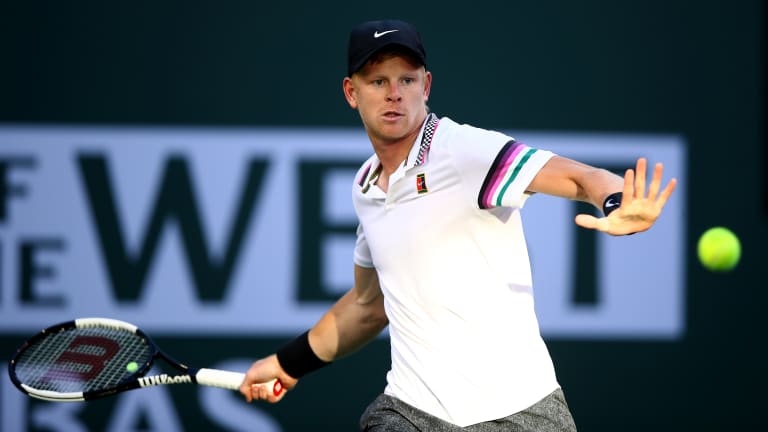ATP, ITF making hasty adjustments to revamp of tennis's minor leagues
By Kamakshi Tandon Mar 21, 2019"Done with my crashout": Naomi Osaka ready for reset after losing Madrid opener
By Baseline Staff Apr 24, 2025REPORTS: Carlos Alcaraz to announce Madrid withdrawal amid injury struggles
By TENNIS.com Apr 24, 2025Madrid Open Betting Preview: Borna Coric vs. Matteo Arnaldi
By Zachary Cohen Apr 24, 2025FIRST LOOK: Coco Gauff to debut new Miu Miu x New Balance tennis collection in Rome
By Stephanie Livaudais Apr 23, 2025The Oeiras Open, which Carlos Alcaraz won four years ago, has one of the most beautiful Center Courts in the world
By Florian Heer Apr 23, 2025Reilly Opelka's latest 'rating' revealed: the views from his hotel room in Madrid
By Baseline Staff Apr 23, 2025Alexandra Eala vs. Iga Swiatek: Where to Watch, Madrid Preview, Betting Odds
By TENNIS.com Apr 23, 2025Italian teenager Federico Cina, 18, scores second ATP Masters 1000 victory with Madrid win
By Associated Press Apr 23, 2025Lithuanian-born, Spanish-trained Vilius Gaubas is ready to take on the world
By Florian Heer Apr 23, 2025ATP, ITF making hasty adjustments to revamp of tennis's minor leagues
Many players are thinking about giving up on their dreams, which has sparked conversation.
Published Mar 21, 2019
Advertising
As player unrest mounts, the ITF and ATP are making hasty adjustments to their revamp of tennis's minor leagues.
At the beginning of this season, the ITF introduced a new World Tennis Tour in an attempt to streamline the lowest levels of the game. This included smaller qualifying draws to reduce tournaments to seven days, and establishing two different ranking systems—one at the ITF level and another for the ATP and WTA tour. These were accompanied by ATP changes to Challenger events that severely reduced qualifying draws while also reserving some spots for ITF-ranked players to gain entry.
Now, steps are being taken to increase the size of qualifying draws and provide more playing opportunities.
It follows widespread confusion about the new structure that has left potentially thousands of lower-ranked players sitting on the sidelines because they cannot get entry into events. Criticism and scrutiny has been building in recent weeks. A recent protest letter to the ITF from Croatia's Ana Vrljic was signed by 700 players, and an online petition by Maria Patrascu now has more than 15,000 signatures.
Even Roger Federer has been taking note, mentioning it among the top issues for the sport's governing bodies to address.
"I have a lot of open questions," he said at Indian Wells, speaking to journalists from Switzerland. "There have been big changes on the futures tour. There are people, including me, who do not get exactly the way it works with the [ITF] circuit points and the ATP points. It needs to be integrated. Not everyone has the same priorities."
First players meeting against these new ITF rules! We all disagree with these new changes! We want to change this and we are going to fight for this!! #savetennis pic.twitter.com/HkoA4Q4jwb
— Juan Pablo Paz (@Juanp_paz) March 15, 2019
Advertising
One of the biggest complaints has been around restricting qualifying to 24 players at ITF events, which previously could have anywhere from 32 to 128 players. Between the eight to 10 lower-level ITF events held each week, it reduced by hundreds the amount of spots that are offered to aspiring players, with a higher ranking often required to get entry into the same event.
The introduction of dual rankings also threw the system into disarray. Previously, lower-ranked players could move back and forth between ITF and ATP or WTA events, collecting points that all went towards their tour ranking. But dividing them in two left many players caught between the two systems, sometimes ranked on both but not high enough to get into either ITF or ATP and WTA events.
Players have also opposed the use of a match tiebreaker in qualifying, saying it does not provide proper competition.
They have made themselves heard. This week, theITF announced further changes, also acknowledging that more needs to be done. The new measures include allowing the qualifying draw for ITF $15,000 and $25,000-and-up events to be increased from 24 to 32 players, introducing protected ranking rules and some recognition of doubles specialists. It also said it was looking at whether to further increase qualifying to 48 players, though still keeping seven-day events. There will also be regulation of pre-qualifying, with players saying tournaments frequently will not allow them to compete unless they stay at the high-priced official hotel.
The ATP also approved plans at a recent board meeting to introduce new $35,000 Challengers, and increase the amount of spots given to ATP players in Challengers.
New Challenger qualifying rules. All it did was literally flip flop. Now 0 spots to ITF players and 3 to ATP. Still the same amount of opportunities. It added 2 more playing opportunities to ATP players but took away 2 from ITF. pic.twitter.com/UDk9MlDYgX
— Jared Hiltzik (@JaredHiltzik) March 13, 2019
Advertising
But these initial steps are unlikely to quell the controversy. The stated goal of the changes is to reduce the amount of professional tennis players with ATP or WTA rankings and improve their earnings. Research, as previously conducted and published by the ITF, has indicated that there are 14,000 players who play at least one professional event and 3,000 who regularly compete, but just 600 who earn enough to break even across the men's and women's tours. The aim of the transition tour was to create a smaller group of 750 men and 750 women with ATP or WTA rankings.
So far, though, the drop has been far more steep—according to the ITF, just 650 women and 300 men are currently getting a foothold in the new system.
Some also question whether reducing the amount of players is the correct approach at all. Former Grand Slam finalist Magnus Norman, who coaches Stan Wawrinka, also has 10 players ranked between 300 and 800 at his Good to Great Tennis Academy in Sweden. He says playing opportunities for them have been halved.
"They have hopes and they have dreams, and they have a passion to work hard and a passion to maybe succeed down the road," Norman told TENNIS.com in an interview at Indian Wells. "And it's a little bit sad to see that they don't have any possibility to play any tournaments.
"They have a tough time financially, but they find a way to get by—getting sponsors, by playing league tennis in Germany. Right now some of them are thinking about quitting tennis."
Turning players away could have effects for the game as a whole, he added, saying, "I don't think any tennis player quitting tennis is good for tennis. We want players to get involved for a long time. Maybe they will not actually be professional tennis players, but they maybe will have a career coaching or in managing...whatever. We want people involved in tennis."
Some players do not oppose the new system, saying those with ability will find their way to the top anyway. But it might have pulled the rug away from many others.
We have a player supporting the Transition Tour! He is 🇮🇳 Sasi Kumar Mukund, 22 y/o, ATP #268 and ITF #597. He started playing Challengers regularly in 2018. pic.twitter.com/3W3juHZrfB
— Luis (@lu_tenis) March 19, 2019
Advertising
While top-ranked juniors now get special spots at ITF events, those who cannot play a lot of junior events or are older have it tougher. The USTA has created some openings for its college players, but not for for players from other countries.
Toni Nadal is the latest public figure who disagrees with the Transition Tour. pic.twitter.com/Y6V6by91Ii
— Luis (@lu_tenis) March 3, 2019
Advertising
Sven Groeneveld, another established coach who has worked with Ana Ivanovic and Maria Sharapova, says it has changed the equation for aspiring professionals.
"I have a player that's leaving college, and he's asking me if should go pro. I said, 'I don't know.' Because the pathway is so much tougher now," he told TENNIS.com. "For him to enter tournaments with no ATP ranking, you have to play ITF tour, and even then, they have reduced the qualifying. So I'm saying, 'Listen, they've made it much tougher.' So to be honest with you, I'd rather just get you a Masters in Finance. And for the same amount or less [as] getting a Masters in Finance, you could probably spend double that money, and you may not even get the chance of playing Challengers."
Groeneveld also spoke of a perceived lack of transparency and the antagonism created by the changes.
"You have so many active players complaining, and you have so many people questioning, and you have rumors about why you no longer have ATP points," he said. "We need to work together. My concern is with the health of the sport, and right now, it's not healthy."
Both the ITF and ATP have blamed each other for the lack of rankings cooperation, saying it was not them that refused to allow more ATP points. There are suggestions that the points reduction was prompted by the ATP because some players were getting so many points at ITF events they could enter Grand Slam qualifying and not play any Challengers. Even more speculation surrounds the ITF's multi-million dollar agreement to sell scoring to Sportradar, and the recent Independent Review Panel looking at fixing in the sport.
The IRP's recommendations include that the ITF stop selling data from some events, and other changes like having the seven-day events that led to the reduction of qualifying spots. There have been questions about whether the new system is designed not to improve lower-level competition but to allow governing organizations to meet IRP obligations and keep data sales.

ATP, ITF making hasty adjustments to revamp of tennis's minor leagues
© Getty Images
Advertising
Mark Petchey, a former ATP player and now a coach and commentator, questioned the process behind the changes.
"As far as the ITF will say, they did a 55,000-person study, but everybody that I've spoken to—they weren't involved in it," he told TENNIS.com. "And I'm not sure if you added up the amount of players, coaches, that you could get to that number.
"There's a lot of us sitting around here saying—actually, who were these people that were asked their opinion, and have they been a parent, have they been a coach, have they run a tennis academy?"
The ITF hasinsisted on the accuracy of its survey figures.
The central and longstanding problem is the lack of earnings both by players and tournaments at this level. The amount of ITF and Challenger events also appears to have decreased so far this season, despite efforts to reduce expenses by reducing the length of tournaments and removing a requirement for organizers to hold multiple ITF events.
Recent prize-money increases and fewer players may not have helped.
"I don't think it should be someone sitting in an office saying you can't follow your dream because you can't get into a tournament," said Petchey, who has two daughters that play tennis. "Because 90 percent of those players are actually putting money into the system. They're paying hotels, for strings, buying food and beverages on site. There is a massive downstream effect on tennis academies worldwide, on tennis coaches, on tennis clubs.
"So this will have an effect on the amount of people that have picked up a tennis racquet or have a dream of being a professional tennis player."
While the changes are intended to help a select few reach the top, the goal of a large portion of pros is simply playing, competing, and earning a ranking.
"It wasn't the money, it was the points," said Petchey. "And now they've taken away the points."

ATP, ITF making hasty adjustments to revamp of tennis's minor leagues